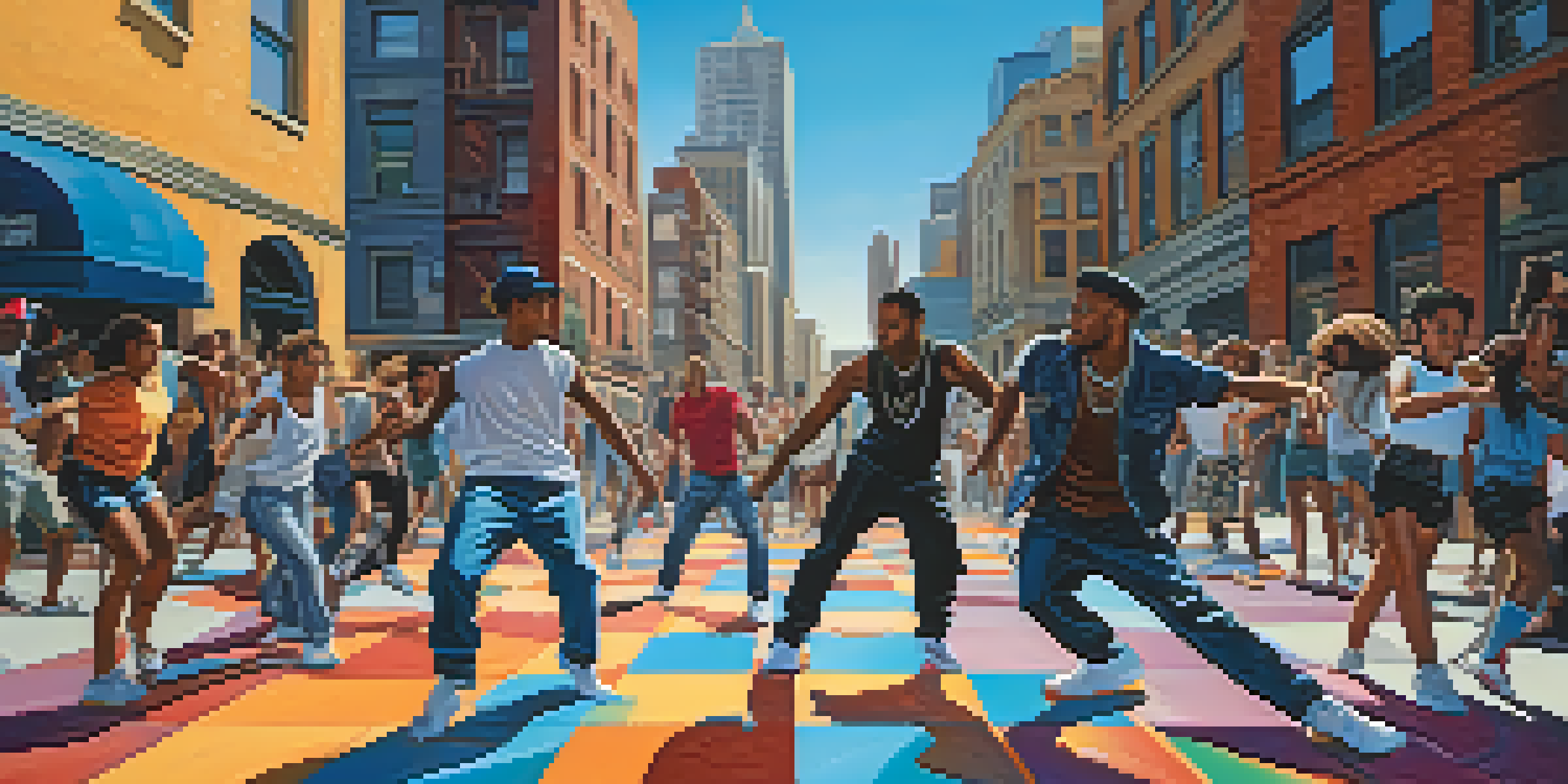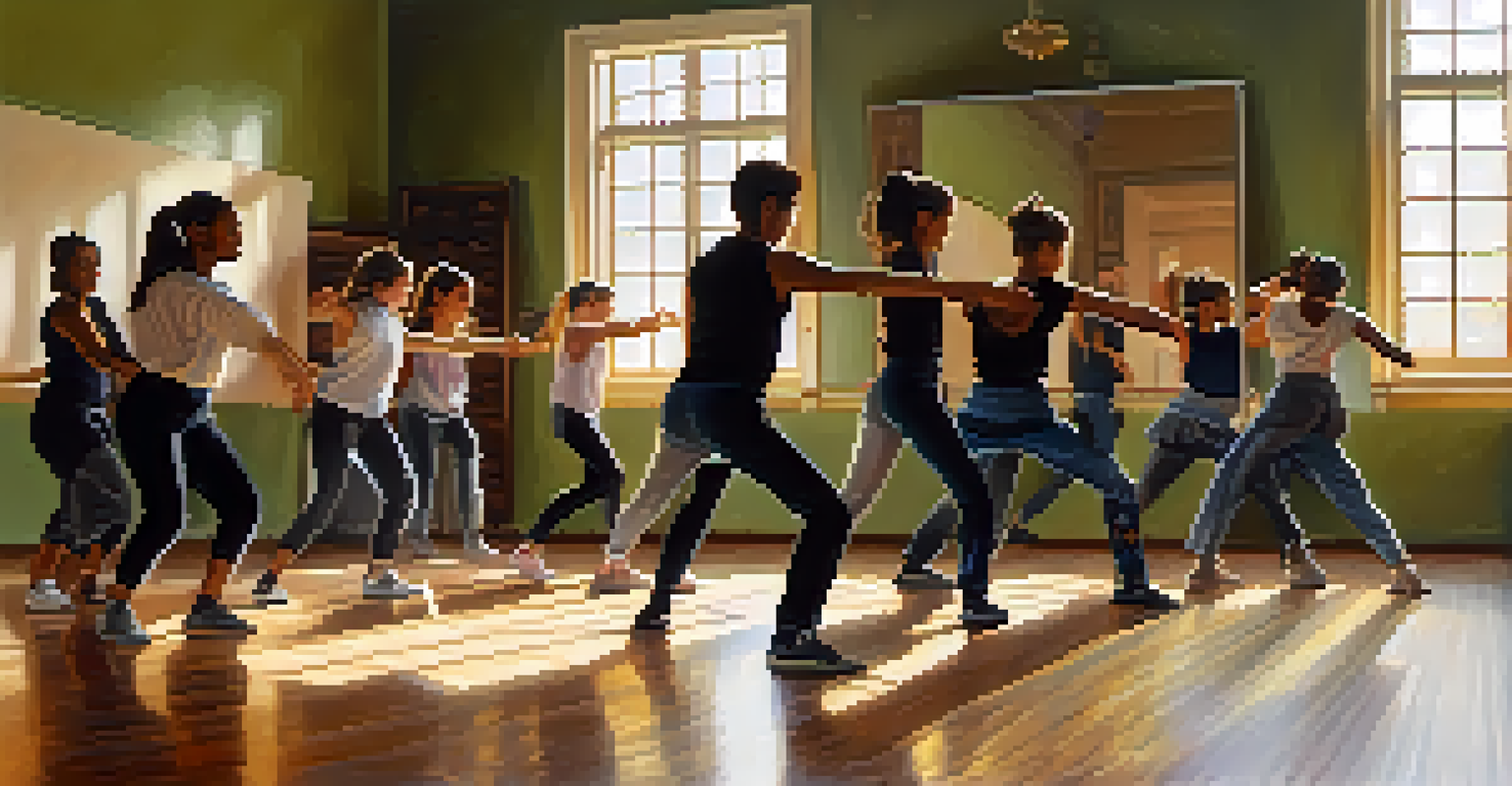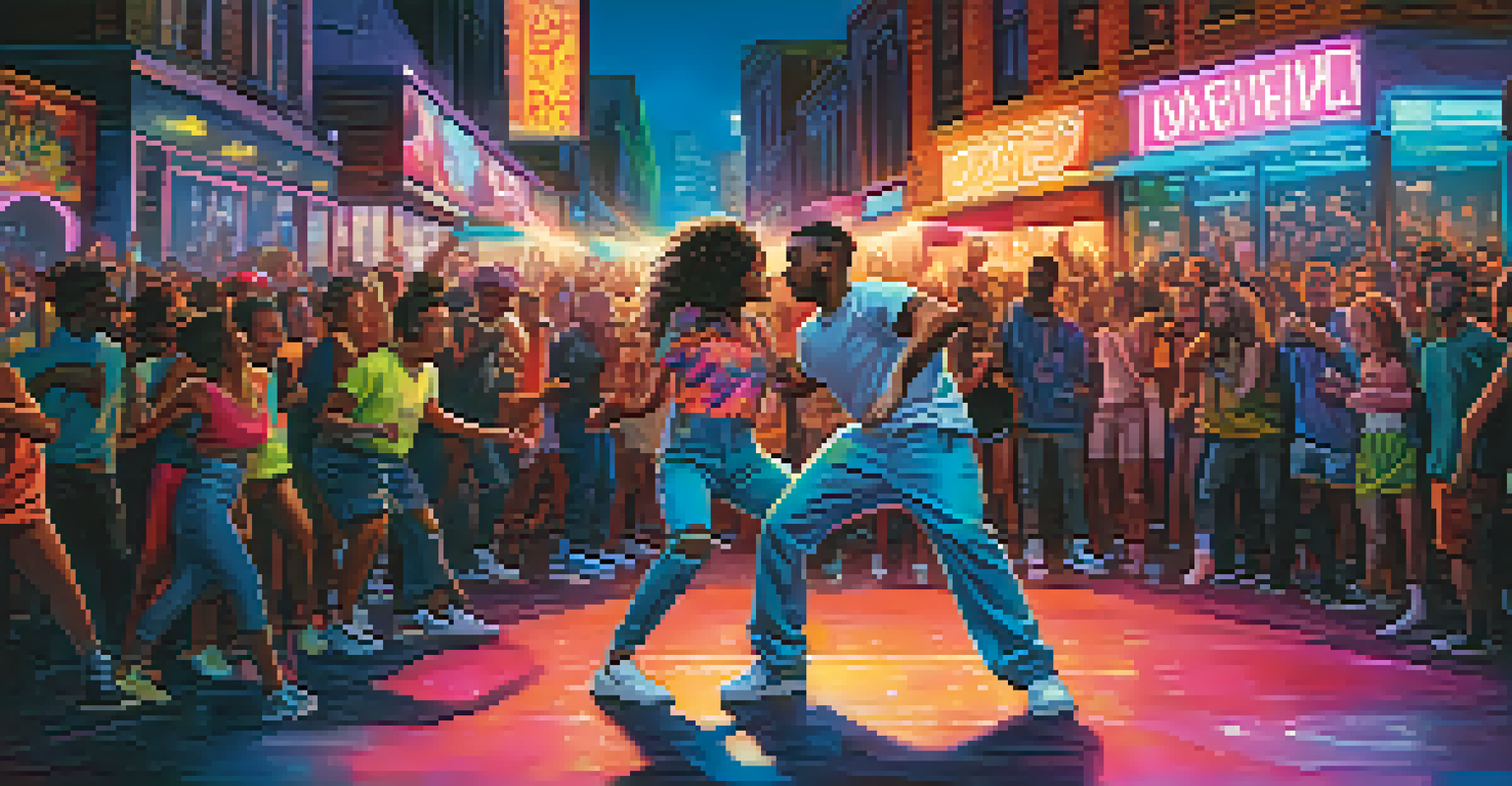Street Dance: The Cultural Innovation Behind Urban Movement

The Origins of Street Dance: A Cultural Mosaic
Street dance has deep roots in various cultural traditions, reflecting the rich tapestry of urban life. It emerged in the late 20th century, particularly in the United States, where diverse communities infused their styles and stories into the movement. From the funky grooves of breakdancing to the intricate footwork of locking and popping, each style tells a unique story shaped by its cultural background.
Dance is the hidden language of the soul.
These dances often originated in response to social and economic challenges, giving voice to marginalized communities. For instance, breakdancing emerged from the Bronx, offering a creative outlet for youth amid urban struggles. This cultural innovation not only provided a means of expression but also fostered a sense of identity and belonging among dancers.
As street dance spread globally, it absorbed influences from various cultures, creating a dynamic and constantly evolving art form. Today, it serves as a bridge connecting different communities, showcasing how dance can unite people through shared experiences and creativity.
The Evolution of Street Dance Styles Over Time
Street dance is not static; it evolves continuously, reflecting changes in society and technology. From its inception, styles like breakdancing, locking, and popping have adapted to contemporary music genres, from hip-hop to electronic dance music. This evolution illustrates how street dance remains relevant, appealing to new generations of dancers and audiences alike.

In the early days, street dance was predominantly performed in informal settings like streets and parks. However, with the rise of social media and dance competitions, these styles have found new platforms for exposure and innovation. Dancers now showcase their skills on platforms like Instagram and TikTok, contributing to the rapid evolution of styles.
Street Dance: A Cultural Expression
Street dance reflects diverse cultural backgrounds and serves as a voice for marginalized communities.
Moreover, the blending of various influences has led to the emergence of hybrid styles, where dancers incorporate elements from traditional forms and modern techniques. This fusion creates fresh expressions of movement, keeping street dance vibrant and exciting. The continuous cycle of influence and adaptation ensures that street dance is always at the forefront of cultural innovation.
Street Dance as a Form of Social Commentary
Street dance is not just about movement; it serves as a powerful tool for social commentary. Dancers often use their performances to address social issues, from racial inequality to economic disparity. Through their art, they highlight struggles, celebrate resilience, and inspire change, making dance a vehicle for activism.
The dance is a poem of which each movement is a word.
For example, many street dance battles and performances incorporate themes that resonate with the audience's lived experiences. Dancers share their stories through choreography, using their bodies to express feelings that words sometimes cannot capture. This storytelling aspect connects deeply with viewers, fostering empathy and understanding.
In this way, street dance functions as a mirror reflecting societal challenges while simultaneously offering hope and unity. By consciously weaving social messages into their performances, dancers create a dialogue that transcends cultural and geographical boundaries, illustrating the profound impact of urban movement.
The Role of Community in Street Dance Culture
At its core, street dance is about community. Dancers often come together to practice, share techniques, and support one another, creating a sense of belonging that is integral to the culture. These communities foster collaboration, inspiring dancers to push their creative limits and develop their unique styles.
Events like dance battles and workshops bring people together, allowing dancers from different backgrounds to connect and learn from each other. These gatherings not only showcase talent but also encourage mentorship, where experienced dancers guide newcomers. This exchange of knowledge strengthens the community and keeps the culture alive.
Community Shapes Street Dance Culture
The sense of community in street dance fosters collaboration, mentorship, and the sharing of creative expression.
Moreover, the sense of community in street dance extends beyond the dance floor. Many dancers actively engage in outreach programs, teaching younger generations the importance of self-expression and creativity. By investing in their communities, they ensure that the legacy of street dance continues to thrive, enriching urban culture for years to come.
Street Dance and Its Impact on Global Culture
The influence of street dance has transcended borders, becoming a global phenomenon that resonates with diverse cultures. From Asia to Europe, street dance has inspired countless dancers to explore its forms, leading to a unique blend of local and global styles. This cross-cultural exchange enriches the dance community, creating a vibrant tapestry of movement.
International dance competitions and festivals further showcase the global reach of street dance. Events like the Red Bull BC One and World of Dance highlight the best talent from around the world, fostering a spirit of competition while celebrating cultural diversity. These platforms allow dancers to share their styles, techniques, and stories, cultivating a sense of unity among participants.
As street dance continues to spread, it challenges traditional notions of dance and performance. It encourages individuals to embrace their authenticity and express themselves freely, regardless of cultural background. This cultural innovation not only enhances the art form but also fosters a greater understanding and appreciation of diverse expressions of movement.
The Connection Between Street Dance and Music
Music and street dance share an inseparable bond, with each influencing the other in profound ways. The rhythms, beats, and lyrics of hip-hop and other genres provide the backdrop for street dance, shaping its movements and styles. Dancers often interpret music through their bodies, creating a dynamic interplay between sound and movement.
For instance, breakdancers often respond to the tempo and energy of the music, using it as a guide for their improvisation. The connection between music and dance allows for a unique form of expression, where dancers communicate emotions and stories without words. This synergy enhances the overall experience, captivating audiences and leaving a lasting impression.
Innovation Through Music and Tech
The evolving relationship between music and technology drives innovation in street dance, inspiring new movements and connections.
Moreover, as musical genres evolve, so does street dance. The emergence of new musical styles encourages dancers to explore fresh movements and techniques, pushing the boundaries of creativity. This reciprocal relationship ensures that both street dance and music continue to innovate, inspiring future generations of artists and audiences alike.
The Future of Street Dance: Trends and Innovations
As we look to the future, street dance is poised for continued growth and innovation. With the rise of digital platforms and virtual events, dancers now have unprecedented opportunities to showcase their talent and connect with audiences worldwide. This digital shift opens doors for creative collaborations and new forms of expression, ensuring that street dance remains relevant.
Additionally, the integration of technology into street dance is paving the way for exciting possibilities. From augmented reality performances to interactive dance tutorials, technology is reshaping how dancers create and engage with their art. These advancements offer fresh avenues for exploration, encouraging dancers to experiment with their styles and push the boundaries of traditional movement.

Ultimately, the future of street dance lies in its ability to adapt and resonate with new generations. By embracing change while honoring its roots, street dance will continue to thrive as a vibrant cultural force, inspiring creativity and connection in urban environments around the globe.